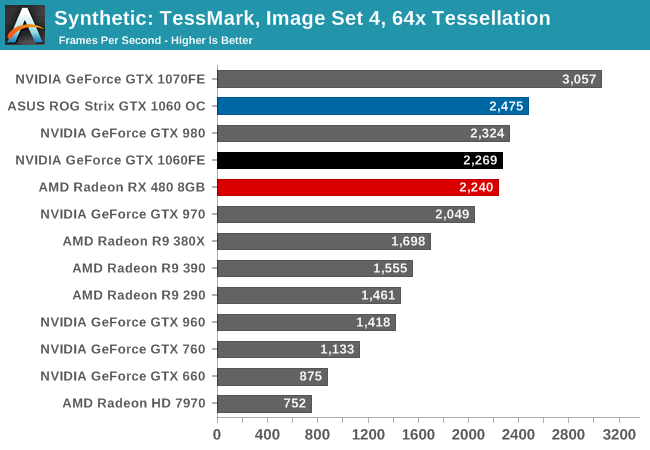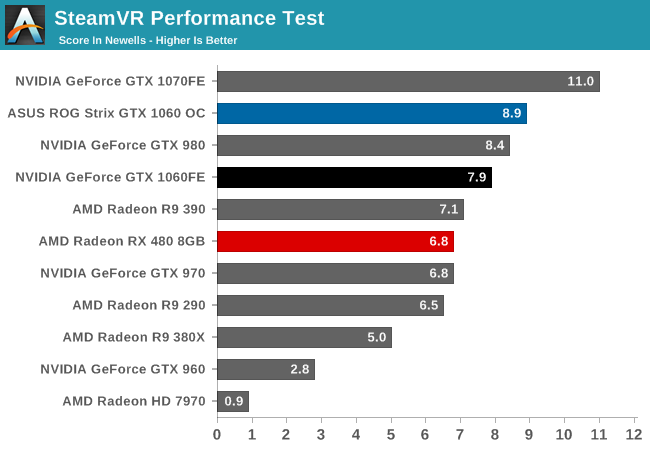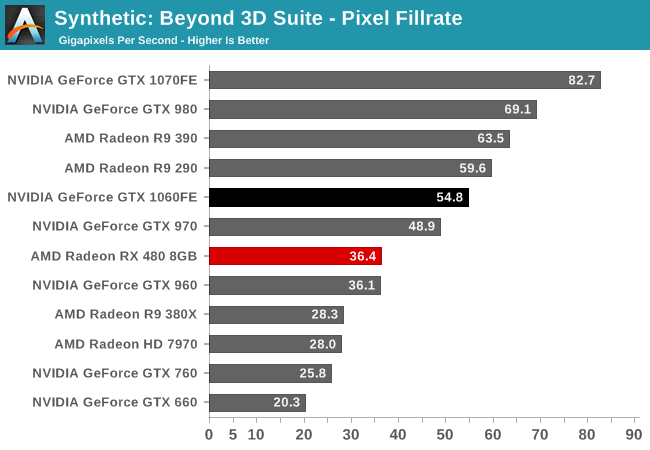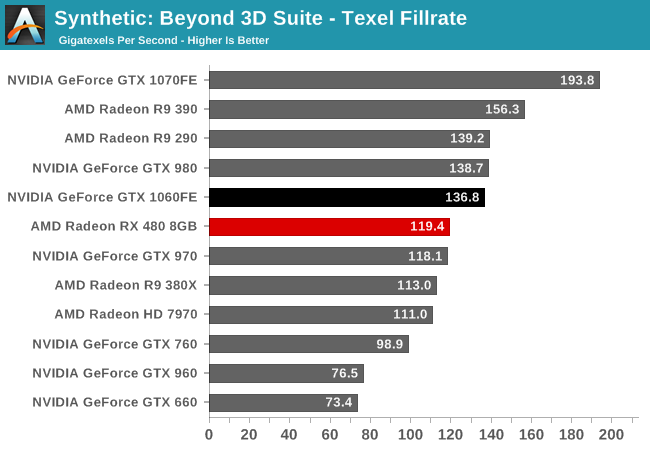The GeForce GTX 1060 Founders Edition & ASUS Strix GTX 1060 Review
by Ryan Smith on August 5, 2016 2:00 PM ESTSynthetics
As always we’ll also take a quick look at synthetic performance. While GTX 1060 is of course a cut down Pascal architecture part, how it has been cut down is interesting. Compared to GP104, GP106 has half the SMs and GPCs, but 3/4 the ROPs, which may prove to have an impact.

Starting off with tessellation performance, we find the GTX 1060 coming in just behind the GTX 980, showing that NVIDIA’s performance estimates generally apply not only to games, but synthetic tests as well. But perhaps more interesting is the fact that the card is neck-and-neck with the Radeon RX 480. NVIDIA has traditionally enjoyed a sizable geometry performance lead over AMD cards, but it looks like those days have come to a close.
Up next, we have SteamVR’s Performance Test. While this test is based on the latest version of Valve’s Source engine, the test itself is purely synthetic, designed to test the suitability of systems for VR, making it our sole VR-focused test at this time. It should be noted that the results in this test are not linear, and furthermore the score is capped at 11. Of particular note, cards that fail to reach GTX 970/R9 290 levels fall off of a cliff rather quickly. So test results should be interpreted a little differently.

As NVIDIA’s now entry-level VR card, GTX 1060 looks very good in the Steam VR test. A score of 7.9 Newells means that it’s comfortably above the 6.x range generally required, and it also means the GTX 1060 is comfortably ahead of the RX 480 in this scenario.
Finally, for looking at texel and pixel fillrate, we have the Beyond3D Test Suite. This test offers a slew of additional tests – many of which use behind the scenes or in our earlier architectural analysis – but for now we’ll stick to simple pixel and texel fillrates.

Starting with the pixel fillrate, we can see the impact of GTX 1060’s slightly more unusual ROP and GPC arrangement when it’s compared to the GTX 980. At 54.8 GPixels/second, GTX 1060 trails GTX 980 significantly. The card not only has fewer ROPs, but it has half of the rasterizer throughput (32 pixels/clock) as GTX 980. As we’ve seen in our gaming benchmarks the real-world impact isn’t nearly as great as what happens under these synthetic tests, but it helps to explain why sometimes GTX 1060 is tied with GTX 980, and other times it’s several percent behind. If nothing else, at an architectural level this is what makes GTX 1060 a better 1080p card than a 1440p card.

As for texel throughput, things are right where we expect them. GTX 1060 is virtually tied with GTX 980, and while it’s ahead of RX 480 in the process, it’s not by a massive amount.










189 Comments
View All Comments
Mikuni - Saturday, August 6, 2016 - link
Avidemux works pretty well.onemoar@gmail.com - Saturday, August 6, 2016 - link
here is my luxmark scoreoverclocked EVGA GTX 1060SC
http://www.luxmark.info/node/2919
Mustalainen - Saturday, August 6, 2016 - link
I think i have commented once or twice on any article here but just had to do it again. The people in the comment section are just out right arrogant. You expect the reviewer to provide the detailed reviews on the same day a product is released? Can you guys cut the guys at Anandtech some slack? I bet they do their best in order to provide us with these reviews (which by the way are free). If you are not happy with the quality of the article, go somewhere else (but i bet you always come back here just because these guys do a great job). So what if the review is lagging with a month or two, if you are such an enthusiast go and buy the card/device yourself.fanofanand - Saturday, August 6, 2016 - link
They would receive their samples weeks ahead of time. How do you think so many day 1 reviews get posted?Sushisamurai - Saturday, August 6, 2016 - link
there is some truth to @fanofanand, but that's assuming anandtech also gets their review samples ahead of time as well - which you really can't prove. Those assumptions can be toxic.Mustalainen - Sunday, August 7, 2016 - link
So assuming this is not the authors full time job they should try to rush the review for the release date? And as stated in the other comment, you can only assume they get review samples ahead of time? There are so many day 1 reviews from other sources because when they have receive the review sample the review is about reading the technical details on the box (and test 5-10 different games and report the fps if its a gpu). Do you want Anandtech to become such an site?yannigr2 - Saturday, August 6, 2016 - link
This review makes GTX 1060 look much better than RX 480, compared to other reviews. Just an observation.MarkieGcolor - Saturday, August 6, 2016 - link
Agreed. AMD really needs to release their high end. I wonder if they are in cahoots with Nvidia. Why wouldn't they release a card that can beat titan x when they totally could? With this new process both companies are holding backsilverblue - Sunday, August 7, 2016 - link
Vega isn't ready yet, that's why they've not done it.Jman13 - Tuesday, August 9, 2016 - link
That's because they ignored a lot of things where the 480 is better: such as DX12 on RotTR, where the 480 pulls essentially even with the 1060. The games list also ignores Doom, which is a HUGE win for the 480, and is included in most other review sites games suites. I understand the difficulty in altering and adding games to the suite, but I do think the discussion could have focused on the fact that there is a split between these two cards depending on which APIs are used. The 1060 is clearly the better card in DX 11 games. The 480 has generally performed very well in DX 12 games, being even in some and notably better in others. The only Vulkan game, Doom, shows a HUGE lead for the RX 480, but who knows how representative that is at this point.Long term, the 480 will probably be the faster card for newer games that use DX12, while the 1060 will be faster for most current and older games, as well as several newer games for the next year.